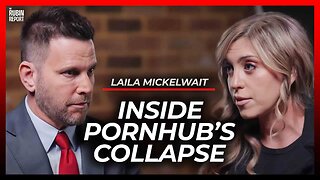Premium Only Content

Edward Bernays and The Committee of 300
The Committee on Public Information (1917–1919), also known as the CPI or the Creel Committee, was an independent agency of the government of the United States under the Wilson administration created to influence public opinion to support the US in World War I, in particular, the US home front.
In just over 26 months (from April 14, 1917, to June 30, 1919) it used every medium available to create enthusiasm for the war effort and to enlist public support against the foreign and perceived domestic attempts to stop America's participation in the war. It is a notable example of propaganda in the United States.
Organizational history
"U.S. Official War Pictures", CPI poster by Louis D. Fancher
Establishment
President Woodrow Wilson (the 28th president) established the Committee on Public Information (CPI) through Executive Order 2594 on April 13, 1917.[1] The committee consisted of George Creel (chairman) and as ex officio members the Secretaries of: State (Robert Lansing), War (Newton D. Baker), and the Navy (Josephus Daniels).[2] The CPI was the first state bureau covering propaganda in the history of the United States.[3]
Creel urged Wilson to create a government agency to coordinate "not propaganda as the Germans defined it, but propaganda in the true sense of the word, meaning the 'propagation of faith.'"[4] He was a journalist with years of experience on the Denver Post and the Rocky Mountain News before accepting Wilson's appointment to the CPI. He had a contentious relationship with Secretary Lansing.[5]
Activities
Wilson established the first modern propaganda office, the Committee on Public Information (CPI), headed by George Creel.[6][7] Creel set out to systematically reach every person in the United States multiple times with patriotic information about how the individual could contribute to the war effort. It also worked with the post office to censor seditious counter-propaganda.
Creel set up divisions in his new agency to produce and distribute innumerable copies of pamphlets, newspaper releases, magazine advertisements, films, school campaigns, and the speeches of the Four Minute Men.
CPI created colorful posters that appeared in every store window, catching the attention of the passersby for a few seconds.[8] Movie theaters were widely attended, and the CPI trained thousands of volunteer speakers to make patriotic appeals during the four-minute breaks needed to change reels.
They also spoke at churches, lodges, fraternal organizations, labor unions, and even logging camps. Speeches were mostly in English, but ethnic groups were reached in their own languages.
Creel boasted that in 18 months his 75,000 volunteers delivered over 7.5 million four minute orations to over 300 million listeners, in a nation of 103 million people.
The speakers attended training sessions through local universities, and were given pamphlets and speaking tips on a wide variety of topics, such as buying Liberty Bonds, registering for the draft, rationing food, recruiting unskilled workers for munitions jobs, and supporting Red Cross programs.[9]
Historians were assigned to write pamphlets and in-depth histories of the causes of the European war.[10][11]
The CPI used material that was based on fact, but spun it to present an upbeat picture of the American war effort. In his memoirs, Creel claimed that the CPI routinely denied false or undocumented atrocity reports, fighting the crude propaganda efforts of "patriotic organizations" like the National Security League and the American Defense Society that preferred "general thundering" and wanted the CPI to "preach a gospel of hate."[12]
The committee used newsprint, posters, radio, telegraph, and movies to broadcast its message. It recruited about 75,000 "Four Minute Men," volunteers who spoke about the war at social events for an ideal length of four minutes.
They covered the draft, rationing, war bond drives, victory gardens and why America was fighting.
They were advised to keep their message positive, always use their own words and avoid "hymns of hate."[13] For ten days in May 1917, the Four Minute Men were expected to promote "Universal Service by Selective Draft" in advance of national draft registration on June 5, 1917.[14]
The CPI staged events designed for many different ethnic groups, in their language. For instance, Irish-American tenor John McCormack sang at Mount Vernon before an audience representing Irish-American organizations.[15]
The committee also targeted the American worker and, endorsed by Samuel Gompers, filled factories and offices with posters designed to promote the critical role of American labor in the success of the war effort.[16]
As the war progressed, the depiction of the enemy evolved in CPI publications. Initially in 1917, CPI pamphlets emphasized the importance of defending democracy and liberty from the German state.
Over time the distinction between the German state and the German people was blurred. By 1918, following German military advances, pamphlets depicted individuals of German descent living in the United States as a threat.[17]
The CPI's activities were so thorough that historians later stated, using the example of a typical midwestern American farm family, that[18]
Every item of war news they saw—in the country weekly, in magazines, or in the city daily picked up occasionally in the general store—was not merely officially approved information but precisely the same kind that millions of their fellow citizens were getting at the same moment. Every war story had been censored somewhere along the line— at the source, in transit, or in the newspaper offices in accordance with ‘voluntary’ rules established by the CPI.
Creel wrote about the committee's rejection of the word propaganda, saying:
"We did not call it propaganda, for that word, in German hands, had come to be associated with deceit and corruption. Our effort was educational and informative throughout, for we had such confidence in our case as to feel that no other argument was needed than the simple, straightforward presentation of facts."[19]
A report published in 1940 by the Council on Foreign Relations credits the committee with creating "the most efficient engine of war propaganda which the world had ever seen", producing a "revolutionary change" in public attitude toward US participation in WWI:[20]
In November 1916, the slogan of Wilson's supporters, 'He Kept Us Out Of War,' played an important part in winning the election. At that time a large part of the country was apathetic.... Yet, within a very short period after America had joined the belligerents, the nation appeared to be enthusiastically and overwhelmingly convinced of the justice of the cause of the Allies, and unanimously determined to help them win.
The revolutionary change is only partly explainable by a sudden explosion of latent anti-German sentiment detonated by the declaration of war.
Far more significance is to be attributed to the work of the group of zealous amateur propagandists, organized under Mr. George Creel in the Committee on Public Information.
With his associates he planned and carried out what was perhaps the most effective job of large-scale war propaganda which the world had ever witnessed.
Organizational structure
During its lifetime, the organization had over twenty bureaus and divisions, with commissioner's offices in nine foreign countries.[21]
Both a News Division and a Films Division were established to help get out the war message. The CPI's daily newspaper, called the Official Bulletin, began at eight pages and grew to 32.
It was distributed to every newspaper, post office, government office, and military base.[22] Stories were designed to report positive news. For example, the CPI promoted an image of well-equipped US troops preparing to face the Germans that were belied by the conditions visiting Congressmen reported.[23] The CPI released three feature-length films:
Pershing's Crusaders (May 1918), America's Answer (to the Hun) (August 1918), Under Four Flags (November 1918). They were unsophisticated attempts to impress the viewer with snippets of footage from the front, far less sensational than the "crudely fantastical" output of Hollywood in the same period.[24]
To reach those Americans who might not read newspapers, attend meetings or watch movies, Creel created the Division of Pictorial Publicity.[25]
The Division produced 1438 designs for propaganda posters, cards buttons and cartoons in addition to 20000 lantern pictures (slides) to be used with the speeches.[26] Charles Dana Gibson was America's most popular illustrator – and an ardent supporter of the war.
When Creel asked him to assemble a group of artists to help design posters for the government, Gibson was more than eager to help.
Famous illustrators such as James Montgomery Flagg, Joseph Pennell, Louis D. Fancher, and N. C. Wyeth were brought together to produce some of World War I's most lasting images.
Media incidents
One early incident demonstrated the dangers of embroidering the truth.
The CPI fed newspapers the story that ships escorting the First Division to Europe sank several German submarines, a story discredited when newsmen interviewed the ships' officers in England.
Republican Senator Boies Penrose of Pennsylvania called for an investigation and The New York Times called the CPI "the Committee on Public Misinformation."[27]
The incident turned the once compliant news publishing industry into skeptics.[28]
There is some confusion as to whether or not the claims are correct based upon subsequent information published by the CPI.[29]
Early in 1918, the CPI made a premature announcement that "the first American built battle planes are today en route to the front in France," but newspapers learned that the accompanying pictures were fake, there was only one plane, and it was still being tested.[30]
At other times, though the CPI could control in large measure what newspapers printed, its exaggerations were challenged and mocked in Congressional hearings.[31]
The committee's overall tone also changed with time, shifting from its original belief in the power of facts to mobilization based on hate, like the slogan "Stop the Hun!" on posters showing a US soldier taking hold of a German soldier in the act of terrorizing a mother and child, all in support of war bond sales.[32]
International efforts
The CPI extended its efforts overseas as well and found it had to tailor its work to its audience. In Latin America, its efforts were led where possible by American journalists with experience in the region, because, said one organizer, "it is essentially a newspaperman's job" with the principal aim of keeping the public "informed about war aims and activities." The Committee found the public bored with the battle pictures and stories of heroism supplied for years by the competing European powers. In Peru it found there was an audience for photos of shipyards and steel mills.
In Chile it fielded requests for information about America's approach to public health, forest protection, and urban policing. In some countries it provided reading rooms and language education.
Twenty Mexican journalists were taken on a tour of the United States.[33]
Political conflict
Creel used his overseas operations as a way to gain favor with congressmen who controlled the CPI's funding, sending friends of congressmen on brief assignments to Europe.[34]
Some of his business arrangements drew congressional criticism as well, particularly his sale by competitive bidding of the sole right to distribute battlefield pictures.[35]
Despite hearings to air grievances against the CPI, the investigating committee passed its appropriation unanimously.[36]
Creel also used the CPI's ties to the newspaper publishing industry to trace the source of negative stories about Secretary of the Navy Josephus Daniels, a former newsman and a political ally. He tracked them to Louis Howe, assistant to Assistant Secretary of the Navy Franklin D. Roosevelt and threatened to expose him to the President.[37]
As a Wilson partisan, Creel showed little respect for his congressional critics, and Wilson enjoyed how Creel expressed sentiments the President could not express himself.[38][39]
Termination and disestablishment
Committee work was curtailed after July 1, 1918. Domestic activities stopped after the Armistice was signed on November 11, 1918. Foreign operations ended June 30, 1919.
Wilson abolished the CPI by executive order 3154 on August 21, 1919.
The Committee on Public Information was formally disestablished by an act of Congress on June 30, 1919, although the organization's work had been formally completed months before.[40]
On August 21, 1919, the disbanded organization's records were turned over to the Council of National Defense.[40]
Memoirs
Creel later published his memoirs of his service with the CPI, How We Advertised America, in which he wrote:[19]
In no degree was the Committee an agency of censorship, a machinery of concealment or repression. Its emphasis throughout was on the open and the positive.
At no point did it seek or exercise authorities under those war laws that limited the freedom of speech and press. In all things, from first to last, without halt or change, it was a plain publicity proposition, a vast enterprise in salesmanship, the world's greatest adventures in advertising.... We did not call it propaganda, for that word, in German hands, had come to be associated with deceit and corruption.
Our effort was educational and informative throughout, for we had such confidence in our case as to feel that no other argument was needed than the simple, straightforward presentation of the facts.
Criticism
Chris Hedges, Pulitzer Prize-winning journalist, provides a detailed critique of the Creel Commission in his 2010 book Death of the Liberal Class.
He describes the CPI’s work as “a relentless campaign of manipulation of public opinion thinly disguised as journalism,” including manufactured German atrocities and war crimes. [41]
Walter Lippmann, a Wilson adviser, journalist, and co-founder of The New Republic, who was influential with Wilson in his advocacy for the establishment of a pro-war propaganda committee in 1917, may have later been a critic of Creel. [42]
He had once written an editorial criticizing Creel for violating civil liberties, as Police Commissioner of Denver. Without naming Creel, he wrote in a memo to Wilson that censorship should "never be entrusted to anyone who is not himself tolerant, nor to anyone who is unacquainted with the long record of folly which is the history of suppression." After the war, Lippmann criticized the CPI's work in Europe: "The general tone of it was one of unmitigated brag accompanied by unmitigated gullibility, giving shell-shocked Europe to understand that a rich bumpkin had come to town with his pockets bulging and no desire except to please."[43]
The Office of Censorship in World War II did not follow the CPI precedent. It used a system of voluntary co-operation with a code of conduct, and it did not disseminate government propaganda.[18]
Staff
Among those who participated in the CPI's work were:
Edward Bernays, a pioneer in public relations and later theorist of the importance of propaganda to democratic governance.[44]
He directed the CPI's Latin News Service.
The CPI's poor reputation prevented Bernays from handling American publicity at the 1919 Peace Conference as he wanted.[45]
Carl R. Byoir (1886 – 1957), like Bernays, a founding father of public relations in America.
Maurice Lyons was the Secretary of the committee. Lyons was a journalist who got involved in politics when he became secretary to William F. McCombs, who was Chairman of the Democratic National Committee during Woodrow Wilson's presidential campaign of 1912.
Charles Edward Merriam, a professor of political science at the University of Chicago and an adviser to several US Presidents.
Ernest Poole. Poole was the co Director of the Foreign Press Bureau division. Poole was awarded the very first Pulitzer Prize for Fiction for his novel, His Family.
Dennis J. Sullivan, Manager of Domestic Distribution for films made by the CPI.[46]
Vira Boarman Whitehouse, director of the CPI's office in Switzerland.
She repeatedly crossed into Germany to deliver propaganda materials. She later told of her experiences in A Year as a Government Agent (1920)
The Tavistock Institute of Human Relations — Dr. John Coleman's book
The authoritative expose of the greatest brainwashing organization to ever exist in the course of human history revealed in Dr. John Coleman's book, The Tavistock Institute of Human Relations: Shaping the Moral, Cultural, Political, and Economic Decline of the United States of America (2006). The Tavistock Institute is located in the City of London and at Sussex University in England.
The Tavistock Institute of Human Relations — Dr. John Coleman's book, image #1
Dr. John Coleman, the author of 15 books, the best known of which is Conspirators Hierarchy, The Committee of 300, was one of the the first writers to bring the world's attention to the existence of Tavistock, hitherto unknown to press and pundits alike, in a monograph published in 1969.
Since his initial 1969 revelations concerning the pivotal role that Tavistock plays in shaping political, social, educational, and economic 'opinions', especially in the United States, more than a few writers of global conspiracy have attempted to place laurels upon their shoulders for revelations about Tavistock's key influence as the Mother of all Propaganda Ministries, while ignoring the fact that this pioneering work was first published by John Coleman. Dr. Coleman's new book, however, leaves no doubt as to who is the master and who are the students when it comes to the subject of Tavistock. The book is stunning in the new knowledge that it reveals about the hidden role of British oligarchs to shape and control public opinion in order to manipulate the British public (and later the American public) into accepting the notion that war with Germany was necessary in order "to secure a lasting peace." The plan to 'create' public opinion began in 1913 as a propaganda factory centered at Wellington House in London. Sir Edward Grey, the British Foreign Secretary at the time, installed Lord Northcliffe (Britain's most influential newspaper magnate) as its director. Lord Northcliffe's position was over sighted by Lord Rothmere on behalf of the British Crown. The operational staff of Wellington House consisted of Lord Northcliffe, Arnold Toynbee (future director of studies at the Royal Institute of International Affairs), and the Americans, Walter Lippmann and Edward Bernays (nephew to Signund Freud). Funding was initially provided by the Royal family, but soon to include the Rothchilds (related to Lord Northcliffe by marriage) and the Rockefellers. Wellington House would grow into the Tavistock Institute in 1921 after the propaganda "victories" of the First World War and the Federal Reserve banking system (created in 1913) had been secured. (The Forward to the book is re-peinted below from Dr. Coleman's web site) Ken Adachi http://coleman300.com/view_tavistock.htm
The Tavistock Institute of Human Relations Shaping the Moral, Spiritual, Cultural, Political and Economic Decline of The United States of America
FORWARD.
The Tavistock Institute of Human Relations was unknown to the people of the United States before Dr. Coleman exposed its existence in his monograph, The Tavistock Institute of Human Relations: Britain's Control of the United States.
Up to that time, Tavistock had successfully retained its secretive role in shaping the affairs of the United States, its government and its people since its early beginning in London, in 1913 at Wellington House.
Since Dr. Coleman's original article exposing this ultra-secret organization, others have come forward with claims of authorship, which they were unable to substantiate.
Tavistock began as a propaganda creating and disseminating organization centered at Wellington House, which was where the original organization was put together with intent of shaping a propaganda outlet that would break down the stiff public resistance being encountered to the looming war between Britain and Germany.
The project was given to Lords Rothmere and Northcliffe and their mandate was to produce an organization capable of manipulating public opinion and directing that manufactured opinion down the desired pathway to support for a declaration of war by Great Britain against Germany.
Funding was provided by the British royal family, and later by the Rothschilds to whom Lord Northcliffe was related through marriage.
Arnold Toynbee was selected as Director of Future Studies.
Two Americans, Walter Lippmann and Edward Bernays were appointed to handle the manipulation of American public opinion in preparation for the entry of the United States into WWI, and to brief and direct President Woodrow Wilson.
From a somewhat crude beginning at Wellington House, grew an organization that was to shape the destiny of Germany, Britain and more especially the United States in manner that became a highly sophisticated organization to manipulate and create public opinion, what is commonly termed, “mass brainwashing.”
During the course of its evolvement, Tavistock expanded in size and ambition, when in 1937, a decision was made to use the German author Oswald Spengler's monumental work, Untergange des Abenlandes (The Decline of Western Civilization ) as a model.
Previously, Wellington House board members Rothmere, Northcliffe, Lippmann, and Bernays had read and proposed as a guide the writings of Correa Moylan Walsh, in particular, the book The Climax of Civilization (1917) as corresponding closely to conditions that had to be created before a New World Order in a One World Government could be ushered in.
In this endeavor the members of the board consulted with the British royal family and obtained the approval of the “Olympians” (the inner core of the Committee of 300) to formulate a strategy. Funding was provided by the monarchy, the Rothschilds, the Milner Group and the Rockefeller family trusts.
In 1936, Spengler's monumental work had come to the attention of what had become the Tavistock Institute.
In preparation for changing and reshaping public opinion for the second time in less than twelve years, by unanimous consent of the board, Spengler's massive book was adopted as the blueprint for a new working model to bring about the decline and fall of Western civilization necessary to create and establish a New World Order inside a One World Government.
Spengler held it bound to happen that alien elements would be introduced into Western civilization in increasing numbers, and that the West would fail at that time to expel the aliens, thereby sealing its fate, a society, whose inward beliefs and sound convictions would become at variance with its outward profession and thus Western civilization would fall by the wayside in the manner of the ancient civilizations of Greece and Rome.
Tavistock thinking was that Spengler had indoctrinated Western civilization to believe that it would err on the side of Roman civilization, and expel the aliens.
The genetic loss that has fallen upon Europe-and especially on Scandinavia, England, Germany, France- (the Anglo-Saxon, Nordic Alpine Germanic races) that began just before the Second World War is already so great as to be beyond expectations, and continues at an alarming pace under the skilled guidance of the Tavistock managers.
What was a very rare instance became a common occurrence, a black man married to a white women or vice-versa.
The two World Wars cost the German nation almost one quarter of its population. Most of the intellectual energies of the German nation were diverted into war channels in defense of the Fatherland at the expense of science, arts, literature, music and the cultural, spiritual and moral advancement of the nation.
The same could be said of the British nation. The blaze kindled by the British under the direction of Tavistock set all of Europe on fire, and did incalculable damage according to the Tavistock blueprint that matched Spengler's predictions.
Classical and Western are the only two civilizations that could bring a modern renaissance to the world.
They had flourished and progressed just as long as these civilizations remained under the control of the Anglo-Saxon Nordic Alpine, Germanic races.
The unsurpassed beauty of their literature, art, their classics, spiritual and moral advancement of the female sex with a very large corresponding degree of protection, was what distinguished Western and Classic civilizations from others.
It was this bastion that Spengler saw coming under increasing attack and the thinking at Tavistock ran on parallel tracks, but with a totally different goal. Tavistock saw this civilizations a stumbling block to ushering a New World Order, as did the emphasis on protection and elevation of the female sex to a place of high respect and honor.
Thus the whole thrust of Tavistock was to “democratize” the West by an attack on womanhood, and the racial, moral, spiritual and religious foundation upon which Western civilization rested.
As Spengler suggested, the Greeks and Romans were devoted to the social, religious, moral and spiritual advancement and the preservation of womanhood and they were successful for just as long as they were in control and could arrange matters so that government was carried out by a limited number of responsible citizens supported by the general populace below them, all being of the same pure unadulterated race. The planners at Tavistock saw that the way to upset the balance of Western civilization was to force unwelcome changes in the race by removing control from the deserving to the undeserving in the manner of ancient Roman leaders who were supplanted by their former slaves and aliens, whom they had permitted to come and dwell among them.
Tavistock, by 1937, had come a long way from its Wellington House beginnings and the successful propaganda campaign that had turned the British public from being strongly anti-war in 1913 to willing participants through the arts of manipulation with the willing cooperation of news communications media.
The technique was carried across the Atlantic in 1916 to manipulate the American people to support of the war in Europe.
In spite of the fact that the vast majority, including at least 50 U.S. Senators were adamantly opposed to the U.S. getting dragged into what they perceived was essentially a quarrel between Britain and France on the one hand, and Germany on the other, largely over trade and economics, the conspirators were undeterred. At that point Wellington House introduced the word, “Isolationists” as a derogatory description of those Americans who opposed U.S. participation in the war. The use of such words and phrases has proliferated under the expert brainwashing of the Social sciences scientists at Tavistock. Terms like “regime change,” “collateral damage” became almost new English language.
With the Tavistock plan modified to suit American conditions, Bernays and Lippmann led President Woodrow Wilson to set up the very first Tavistock methodology techniques for polling (manufacturing) so-called public opinion created by Tavistock propaganda. They also taught Wilson to set up a secret body of “managers” to run the war effort and a body of “advisors” to assist the President in his decision-making. The Creel Commission was the first such body of opinion-makers set up in the United States.
Woodrow Wilson was the first American president to publicly proclaim himself in favor of a Socialist New World Order inside a Socialist One World Government. His remarkable acceptance of the New World Order is found in his book The New Freedom.
We say “his” book, but actually, it was written by Socialist William B. Hayle. Wilson denounced capitalism. “It is contrary to the common man and it has brought stagnation to our economy,” Wilson wrote.
Yet, at the time, the United States economy was enjoying prosperity and industrial expansion as it had never experienced before in its history:
“We stand in the presence of a revolution—not a bloody revolution, America is not given to spilling blood—but a silent revolution, whereby America will insist upon recovering to practice those ideals which she has always professed, upon securing a government devoted to the general and not the special interests.
We are upon the threshold of a time when the systematic life of the country will be sustained or at least supplemented at every point by government activity. And now we have to determine what kind of a government activity it shall be; whether, in the first place, it shall be directed from government itself, or whether it shall be indirect, through instrumentalities which have already constituted themselves and which stand ready to supersede government.”
The United States, harried, hounded, pushed and shoved is headed on a fast track to the New World Order, propelled along by the Radical Republicans of the War Party who have been taken over by the scientists at the Tavistock Institute for Human Relations.
Just recently I was asked by a subscriber "where do we find the Tavistock Institute?" My response was:
"Look around the U.S. Senate, the House of Representatives, the White House, the State Department, the Defense Department, Wall Street, Fox T.V. (Faux T.V.) and you will see their change agents in every one of these places."
President Wilson was the first U.S. president to “manage” the war through a civilian committee guided and directed by the Bernays and Lippmann from Wellington House, to which we have already made mention.
The resounding success of Wellington House and its enormous influence on the course of American history began before that in 1913.
Wilson had spent almost a year tearing down the protective trade tariffs that had defended the American domestic markets from being overwhelmed by “Free Trade,” essentially the practice of allowing cheap British goods made with cheap labor in India to flood the American market. On October 12, 1913 Wilson signed the bill that was the beginning of the end of the unique American middle class, long the target of the Fabian Socialists. The bill was described as a measure to “adjust tariffs,” but it would have been accurate to describe it as a bill to “destroy tariffs.”
Such was the hidden power of Wellington House that the vast majority of the American people accepted this lie, not knowing or realizing that it was a death knell for American commerce that would lead to NAFTA, GATT and the World Trade Organization (WTO).
Even more astonishing was the acceptance of the Federal Income Tax Act that was passed on September 5, 1913, to replace trade tariffs as the source of revenue for the Federal Government. Income Tax is a Marxist doctrine not found in the U.S. Constitution anymore than the Federal Reserve Bank is found in the Constitution. Wilson called his twin blows against the Constitution, “a fight for the people, and for free business,” and said he was proud to have taken “part in the completion of a great piece of business…” The Federal Reserve Act, explained by Wilson as “reconstructing the Nation's banking and currency system” was rushed through on a flood-tide of propaganda emanating from Wellington House, just in time for the hostilities that began the horror of WWI.
Most historians are agreed that without passage of the Federal Reserve Bank Act, Lord Grey would not have been able to start that terrible conflagration.
The deceptive language of the Federal Reserve Act was under the guidance of Bernays and Lippman who set up a “National Citizen's League” with the notorious Samuel Untermeyer as its chairman, to promote the Federal Reserve Bank, that secured control of the people's money and currency and transferred it to a private monopoly without the victim's consent.
One of the most interesting pieces of history surrounding the imposition of the foreign financial slavery measure was that before it was sent to Wilson for his signature, a copy was given to the sinister Colonel Edward Mandel House as the representative of Wellington House and the British oligarchy represented by the banker, J.P. Morgan.
As to the American people, in whose name the disastrous measure was instituted, they had not the faintest idea how they had been connived, cheated, lied to and utterly deceived. An instrument of slavery was fastened around their necks without the victims ever becoming aware of it.
Wellington House methodology was at its height when Wilson was coached in how to persuade Congress to declare war on Germany, although he had won election on the solemn promise to keep America out of the war then raging in Europe, a great triumph for the new art of public opinion making. It was just that - the poll questions were shaded in such away that the answers reflected the opinions of the public; not their understanding of the questions, nor their understanding of the processes of political science.
https://www.calameo.com/read/000356274b25ed47f3ab7
https://digitalcommons.mtu.edu/cgi/viewcontent.cgi?article=1011&context=ww1cc-symposium
https://www.jstor.org/stable/44779771
https://scholarworks.harding.edu/cgi/viewcontent.cgi?article=1054&context=tenor&https
-
 2:01:46
2:01:46
vivafrei
9 hours agoEp. 254: China to Pay $24 BILLION? Who Owns Embryos? Tulsi was RIGHT on Syria! Prorogation & MORE!
153K125 -
 3:40:55
3:40:55
MyronGainesX
19 hours ago $20.53 earnedFormer Fed Explains Gabby Petito's Murder
82K38 -
 2:18:05
2:18:05
Nerdrotic
9 hours ago $9.54 earnedInvestigations into the Unknown with Micah Hanks | Forbidden Frontier #093
78.4K16 -
 18:54
18:54
The Rubin Report
14 hours agoHow One Woman Outsmarted Pornhub & Exposed Its Dark Secrets | Laila Mickelwait
160K132 -
 LIVE
LIVE
Major League Fishing
5 days agoLIVE! - Bass Pro Tour: Stage 3 - Day 4
912 watching -
 1:05:28
1:05:28
Sports Wars
16 hours agoLebron GOES OFF Over Bronny Hate, Pereira LOSES Belt To Ankalaev At UFC 313, Xavier Worthy Arrested
108K19 -
 10:27
10:27
Tactical Advisor
1 day agoDMR or SPR for Civilian Use?
104K6 -
 8:21
8:21
DEADBUGsays
1 day agoThe Crossbow Killer
98.6K22 -
 8:40
8:40
Tundra Tactical
1 day ago $13.76 earnedThe Executive Order Wishlist.
102K7 -
 7:22:52
7:22:52
SpartakusLIVE
1 day agoSaturday SPARTOON Solos to Start || Duos w/ StevieT Later
186K4